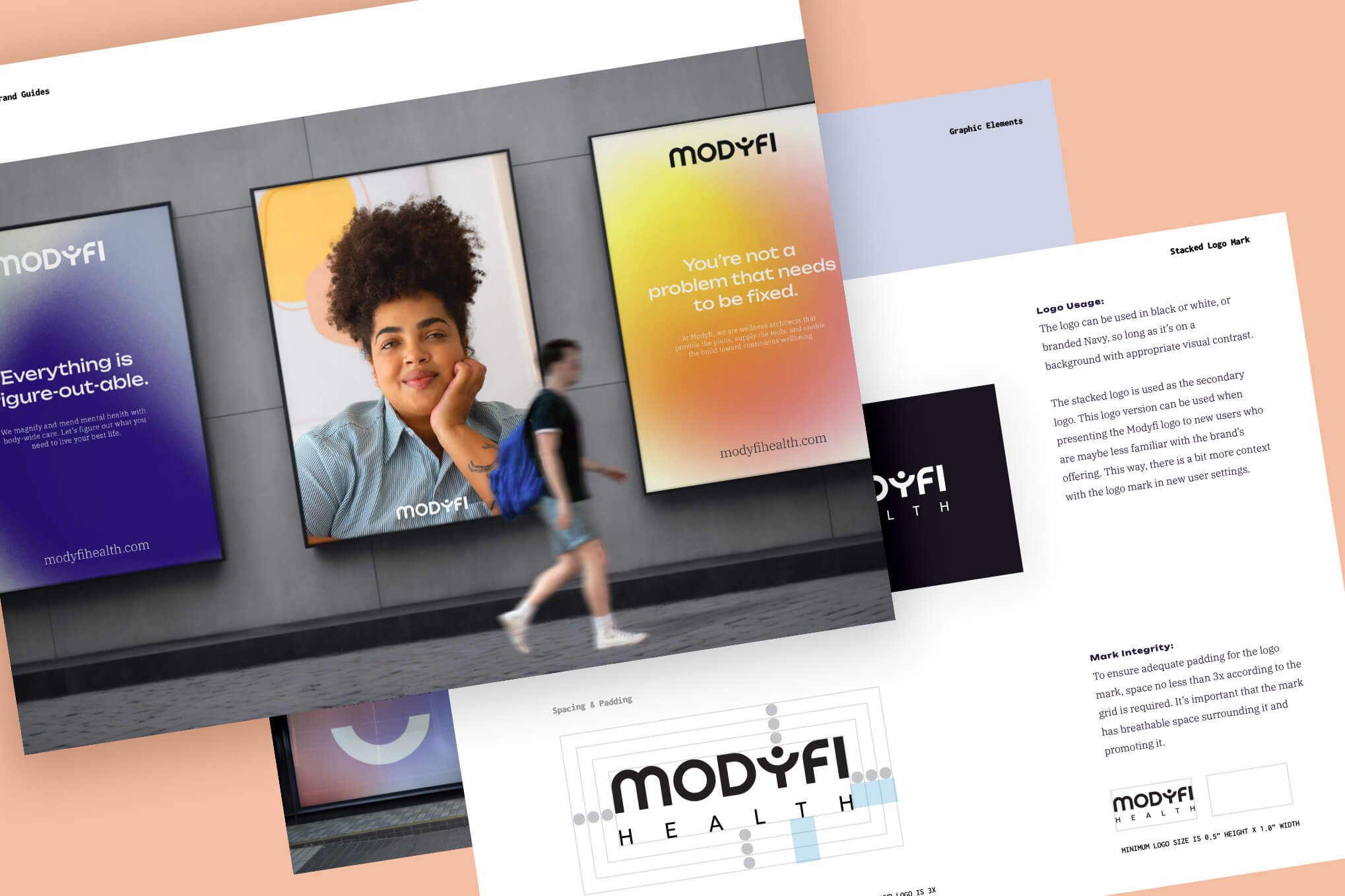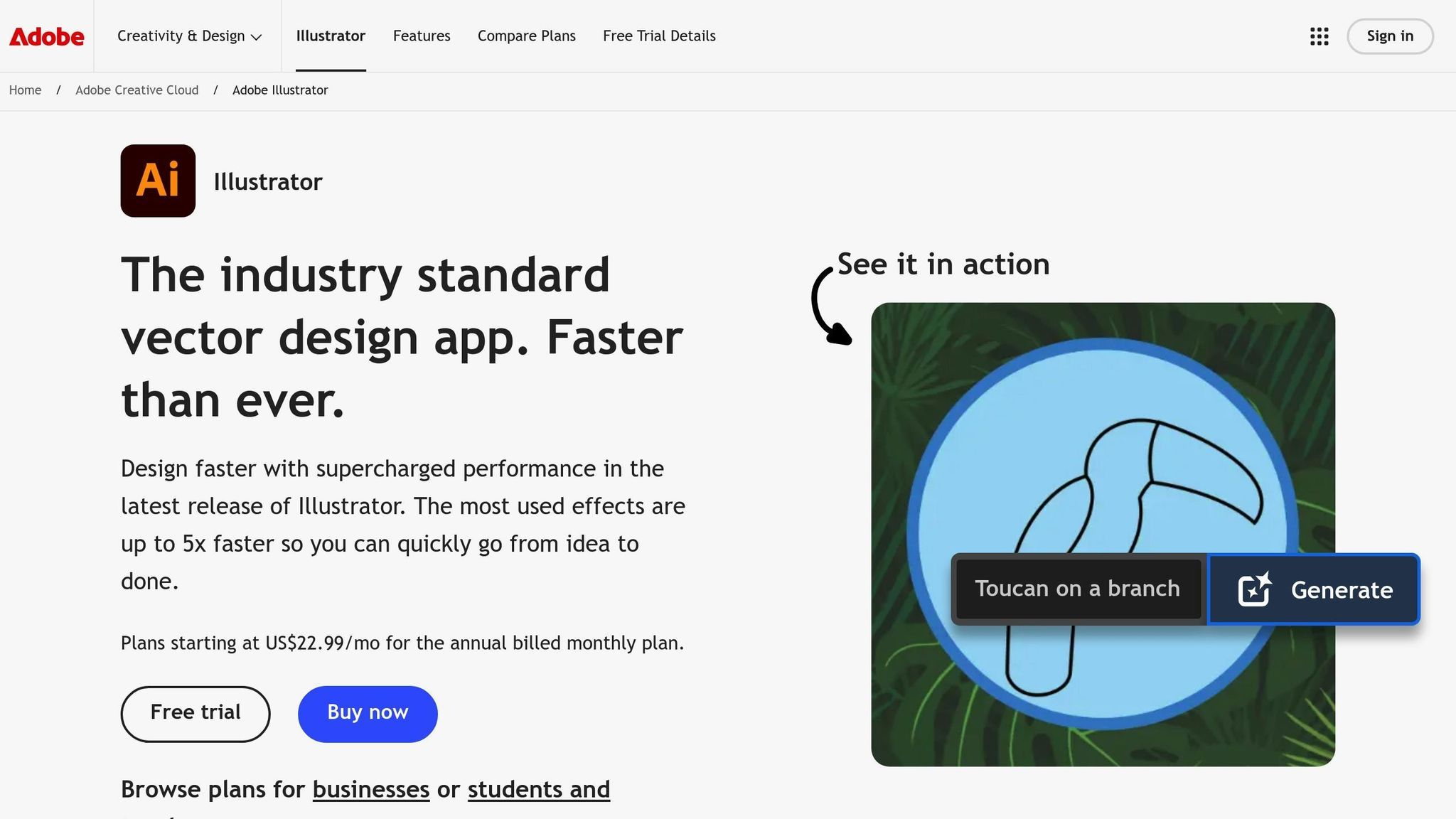
How to Create Brand Guidelines That Work
Brand guidelines are essential for ensuring your business looks and sounds consistent across all platforms. They serve as a manual for maintaining uniformity in logos, colors, typography, tone, and imagery, helping teams avoid confusion and build customer trust. Without them, businesses risk inconsistent visuals and messaging, which can weaken brand recognition.
Here’s what effective brand guidelines cover:
- Logo Usage: Rules for variations, placement, size, and incorrect usage examples.
- Typography: Approved fonts, hierarchy, and accessibility considerations.
- Color Palette: Precise color codes (HEX, RGB, CMYK, Pantone) and usage rules.
- Imagery: Preferred styles for photos, illustrations, and icons.
- Tone of Voice: Defined personality traits, language preferences, and messaging examples.
Why they matter: Consistent branding signals professionalism, builds trust, and simplifies processes for teams, especially as businesses grow or collaborate with external partners.
To create your guidelines:
- Define your brand’s mission, values, and personality.
- Develop visual and verbal identity elements.
- Compile everything in an easy-to-navigate format (PDF or online).
- Update regularly to reflect changes in your business or market.
Whether you’re a small business or scaling rapidly, strong guidelines ensure your brand remains consistent and recognizable everywhere it appears.
How To Build A Brand Guidelines (Template included)
Key Components of Brand Guidelines
Building effective brand guidelines involves covering five core areas that work together to create a consistent and recognizable brand identity. These elements ensure that every aspect of your brand aligns seamlessly.
Let’s break down how critical components – like your logo, colors, and tone – come together to shape a unified identity.
Logo Usage Rules
Establishing clear rules for logo usage is essential to maintaining your brand’s integrity. Start by documenting all logo variations, such as the primary version, horizontal layouts, simplified versions for smaller spaces, and monochrome options.
Clear space guidelines are a must for preserving your logo’s visibility. Define the minimum amount of empty space required around your logo, often measured using the height of a logo element.
Set minimum size requirements for both digital and print formats. For instance, your logo should remain crisp and legible on business cards, social media profile pictures, and website favicons. Specify these minimums in pixels for digital use and inches for print materials.
Include examples of incorrect usage to avoid common mistakes. Show scenarios like stretching the logo disproportionately, using unapproved colors, placing it on cluttered backgrounds, or applying effects such as drop shadows or gradients.
Typography Standards
Typography plays a key role in creating hierarchy and personality in your brand’s communication. Your guidelines should specify both primary and secondary typefaces. For example, your primary font might be used for headlines, while secondary fonts handle body text.
List approved font weights, styles, and hierarchy rules to ensure uniformity. Include examples that show how different text elements – like headings, subheadings, and paragraphs – relate to each other in terms of size, weight, and spacing.
Differentiate between fonts for digital and print use. Since web fonts might not translate seamlessly to print, provide alternatives or include font files to maintain consistency across media. Add rules for line spacing, paragraph spacing, and text alignment to ensure readability and visual balance.
Don’t forget accessibility. Choose fonts that remain legible at various sizes and pair well with your brand colors to ensure adequate contrast for all users.
Color Palette Guidelines
A consistent color palette is vital for brand recognition. Document your primary colors with precise specifications in multiple formats: HEX codes for web, RGB values for digital displays, CMYK percentages for print, and Pantone numbers for professional printing where exact color matching is critical.
Your secondary color palette should complement the primary colors, offering flexibility for different design needs. Include neutral shades like grays, blacks, and whites that balance and enhance your main palette. Specify how and where to use each color – for example, primary colors might dominate logos and headlines, while secondary colors are used for accents or backgrounds.
Define approved color pairings to prevent clashing combinations. Ensure that all color combinations meet contrast standards, particularly for text on backgrounds, to maintain readability and accessibility.
Imagery and Visual Style
Consistency in visuals extends beyond logos and colors to include photography, illustrations, and graphic elements. Define your brand’s photographic style – whether it’s clean and minimal, bright and airy, or warm and inviting. These choices should align with the tone set by your logo, typography, and color palette. Provide examples that highlight preferred lighting, composition, and subject matter.
If your brand uses custom illustrations, outline illustration guidelines. Document details like artistic style, color usage, line weights, and overall aesthetics. This ensures that designs created by different artists feel cohesive.
For iconography, specify standards for user interface elements, infographics, and marketing materials. Whether your icons are outlined, filled, rounded, or angular, maintaining a consistent style creates a polished, professional look across all platforms.
If your brand applies specific filters or treatments to images, include image treatment guidelines. Document any overlay colors, contrast adjustments, or stylistic filters that unify visuals, regardless of the image source.
Tone of Voice and Messaging
Your brand’s personality shines through in its written communication. Establishing clear tone and voice guidelines ensures consistency across all content. Start by defining your brand’s personality traits – is it professional yet approachable? Playful but informative? Authoritative while remaining friendly?
Specify language preferences, including vocabulary, sentence structure, and writing style. For instance, decide whether your brand uses contractions and casual phrasing or maintains a more formal tone. Clarify whether technical terms or industry jargon are appropriate, or if concepts should be explained in simpler terms.
Include grammar and formatting rules to cover punctuation, capitalization, and number formatting. These details may seem small, but they contribute to a polished and cohesive brand presence.
Provide real-world examples of messaging for different contexts, such as social media posts, emails, website copy, and customer service interactions. Concrete examples make it easier for team members to apply voice guidelines effectively, rather than relying solely on abstract descriptions.
How to Create Brand Guidelines
Establishing consistent brand guidelines is the key to ensuring your brand’s identity and values shine through in every interaction. By turning your brand’s core principles into actionable standards, you can create a cohesive framework for your team to follow.
Define Your Brand Foundation
Start by laying out the basics that will guide every design and communication choice. This includes your mission statement, core values, and unique value proposition. Think of these as the compass that keeps your brand pointed in the right direction.
Next, define your brand’s personality. Use clear descriptors that capture its essence and craft a positioning statement. This statement should outline your target audience, the category you operate in, your unique benefit, and the reason your audience should care.
Lastly, identify your audience. Create detailed personas that highlight their values, motivations, and needs. These insights will help ensure your brand resonates with the right people.
Develop Visual Identity Elements
Once your foundation is in place, it’s time to bring your brand to life visually.
-
✓
Logo System
Design a logo with variations for different uses - horizontal layouts for letterheads, stacked versions for social media, and simplified designs for smaller spaces. Consistency is key to maintaining recognition.
-
✓
Color Palette
Choose primary colors that reflect your brand's personality, then add complementary secondary shades. Test these colors across formats like print, digital screens, and varying lighting conditions to ensure they look consistent everywhere.
-
✓
Typography
Pick fonts that align with your brand's personality while staying readable. Select a combination of typefaces that work well together and are versatile enough for digital, print, and email formats. Don’t forget to consider licensing costs and fallback options.
-
✓
Imagery Standards
Create a mood board to define your brand's visual style. Specify the types of photography, illustrations, and graphic elements that match your aesthetic. This ensures all visual content feels unified, whether it’s created in-house or by external collaborators.
Set Verbal Identity Standards
Your brand’s voice is just as important as its visuals. Define it with clear traits – formal or casual, playful or professional – and create messaging frameworks for various scenarios, like product launches or customer interactions.
- Language Preferences: Detail the vocabulary, industry terms, and phrases that fit your tone, as well as words or phrases to avoid. Include grammar and formatting rules that reflect your brand’s personality, like whether to use contractions or the Oxford comma.
- Content Guidelines: Tailor your messaging to fit different channels. Social media posts, for example, will need a different tone and length than email newsletters or website copy. Be specific about tone adjustments, formatting, and length requirements, but make sure everything still feels like it’s coming from the same brand.
Once your visual and verbal identities are clearly defined, it’s time to bring everything together into one cohesive guide.
Compile and Format the Guidelines
Structure your guidelines so they are easy to navigate. Start with the brand foundation, then move into visual and verbal standards. Include a table of contents for quick reference, and consider tailoring versions for different users, like designers, writers, or external partners.
Make the guide visually engaging by embedding examples of your brand elements. Include practical resources like logo files in multiple formats, color swatches, font files, and templates. These should be easy to download and clearly labeled. Providing contact information for questions or asset requests is also essential.
Finally, establish version control. Add dates, version numbers, and a change log to ensure everyone is working with the most up-to-date guidelines. By organizing and formatting your guide thoughtfully, you make it a powerful tool that keeps your brand consistent and recognizable across all platforms.
Tools and Templates for Creating Brand Guidelines
Creating brand guidelines might seem like a daunting task, but with the right tools, it becomes much more manageable. Whether you’re working on a shoestring budget or need professional-grade solutions, there are platforms available to simplify every step of the process.
Using Canva for Design Templates

Canva
Canva is a fantastic option for quickly crafting polished brand documentation. Its Brand Kit feature allows you to upload logos, set color palettes, and define fonts that can be automatically applied across your designs. Here are some starter templates to kick-start your project.
When it comes to building brand guidelines, Canva’s presentation templates are a strong starting point. You can use their business presentation layouts and customize them with your specific brand elements. The platform ensures consistency by applying your saved colors and fonts throughout the document.
Features like the background remover and grid system make it easy to adjust logos and other design elements. Plus, Canva supports team collaboration with built-in commenting tools and shareable view-only links. Need to distribute assets? Canva can generate downloadable packs that include logos, color swatches, and templates, making sharing a breeze.
For more advanced needs, professional design software might be your next step.
Adobe Illustrator for Professional Assets

Adobe Illustrator
For brands that require scalability and precision, Adobe Illustrator is a go-to tool. It’s particularly well-suited for creating vector-based logos, which retain their quality whether used on a business card or a billboard.
Illustrator’s artboard system is a standout feature – it allows you to design and export multiple logo variations in one workspace. Whether you’re creating a primary logo, horizontal version, icon mark, or monochrome alternative, you can handle it all in one place and export them in various formats at once. This ensures consistency across all logo variations while saving time.
The software also offers advanced color tools to ensure accurate matching across both digital and print mediums. You can even save custom color libraries to share with your design team. For typography, Illustrator’s character and paragraph styles let you define exact specifications for headlines, body text, and other elements. You can fine-tune kerning, leading, and tracking to ensure text appears exactly as intended, no matter who implements your guidelines.
For those seeking a fully integrated approach, working with a professional agency can take things to the next level.
How Visual Soldiers Can Help

How to Create Brand Guidelines That Work
Crafting comprehensive brand guidelines often requires a mix of strategic insight and technical know-how. Visual Soldiers offers a seamless blend of both, helping brands navigate the process from start to finish. They combine brand strategy development with visual identity and practical execution, ensuring that every design decision aligns with your broader business goals.
Their process begins with a deep dive into your brand’s foundation, working closely with leadership teams to understand not just how your brand should look, but how it needs to function across different platforms and touchpoints. This strategic groundwork ensures that the visual elements of your brand serve a clear purpose.
Visual Soldiers also specializes in creating interactive brand guideline websites. Unlike static PDFs that often become outdated, these living documents automatically update across your organization whenever changes are made. They can include asset libraries, implementation steps, and even custom tools, ensuring everyone has access to the most current resources.
Their expertise spans industries, allowing them to tailor guidelines to the specific needs of B2B companies, consumer brands, and more. They also bring ADA compliance expertise to the table, ensuring your brand standards are accessible from the start, which can save you from costly revisions down the line.
Maintaining and Updating Brand Guidelines
To keep your brand guidelines effective, regular updates are essential. As your business evolves and the market shifts, your brand standards should adapt to stay relevant and practical.
Review and Update Guidelines Regularly
Set a schedule to review your guidelines – quarterly is a good starting point. Use these reviews to check how well the guidelines are being followed and identify any areas that might be causing confusion. For example, if certain brand elements consistently raise questions from your team, it’s a clear sign those sections need more clarity or detail.
Market trends and internal changes can also signal the need for updates. Major shifts, such as launching a new product, entering a new market, or targeting a different audience, should prompt a thorough review of your brand standards to ensure they align with your current goals.
Once your guidelines are up to date, the next step is making sure everyone on your team can easily access and use them.
Make Guidelines Accessible to Teams
If your team struggles to locate your brand guidelines, they’re unlikely to use them effectively. Store them in a central, cloud-based platform with version control, ensuring everyone has access to the latest version at all times.
For added convenience, consider creating role-specific versions of your guidelines. By tailoring content to specific roles, team members can quickly find the details most relevant to their work without wading through unnecessary information.
Introduce new hires to the guidelines during their onboarding process, showing them where to find the documents and how to use them. This ensures they start off on the right foot. Additionally, whenever updates are made, notify your team immediately – whether through email or messaging tools like Slack – so everyone stays aligned with the latest standards.
Static vs. Dynamic Guidelines
Choosing the right format for your brand guidelines can make a big difference in how effectively they’re used and maintained. Here’s a comparison of static and dynamic formats to help you decide:
| Feature | Static (PDF) | Dynamic (Online) |
|---|---|---|
| Initial Setup | Quick to create | More setup required |
| Updates | Requires recreating document | Real-time updates |
| Asset Downloads | Manual file sharing | Integrated libraries |
| Search Function | Basic PDF search | Advanced search options |
| Collaboration | Email for comments | Built-in feedback tools |
| Version Control | Risk of outdated versions | Always current |
| Offline Access | Accessible without internet | Requires internet |
| Cost | Low ongoing costs | Higher maintenance costs |
Static guidelines, such as PDFs, are simple to create and work well for smaller teams or organizations with infrequent updates. They’re also ideal if your team often works offline or in areas with unreliable internet.
Dynamic guidelines, hosted online, are better suited for larger organizations or fast-paced environments where updates happen frequently. While they require more effort upfront, the ability to make real-time changes and integrate additional tools can save time and reduce miscommunication in the long run.
Many businesses begin with static guidelines and transition to dynamic formats as their needs grow. This gradual approach lets you test what works best for your team before committing to a more advanced system.
Conclusion
Building brand guidelines that truly work lays the groundwork for consistent and recognizable branding across all platforms and interactions. When crafted thoughtfully, these guidelines become the backbone of your marketing efforts, ensuring that your team communicates with a unified voice and maintains a cohesive visual identity.
Key Takeaways
- Clear, consistent guidelines help avoid inconsistencies by standardizing logos, colors, typography, and messaging.
- Strong brand guidelines address key areas like logo usage, color palettes, typography, imagery, and tone of voice, all while being practical for everyday use.
- The process of creating guidelines is just as important as the final document. Start with a solid brand foundation, build your visual and verbal identity step by step, and compile everything in a format that’s easy for your team to access.
- Accessibility is crucial. Housing guidelines in a central location, tailoring versions for specific roles, and including training during onboarding can significantly improve adoption.
- Regular updates ensure your guidelines stay aligned with your business as it grows and evolves.
By focusing on these essentials, you can set your brand on a path toward consistency and clarity.
Final Thoughts
Brand guidelines are not static rules – they’re dynamic tools for guiding your brand’s growth and success. Start small with the basics: logo, colors, fonts, and messaging. You don’t need perfection at the outset; instead, aim for something functional that your team can use right away. Over time, refine and expand based on feedback and evolving needs.
Think of your guidelines as a living resource. When done well, they enhance recognition, streamline marketing efforts, and elevate your brand’s professionalism. Invest the time to create guidelines that work for your team, and your brand will reap the rewards.
FAQs
Static brand guidelines usually come in the form of PDF documents. They’re simple to share but can be a hassle to update. These are a solid choice for well-established brands that rarely tweak their branding and for teams that mainly work offline. The downside? They can quickly feel outdated and may not offer the flexibility growing brands often need.
Dynamic brand guidelines, in contrast, are digital and typically hosted online. This format makes them easy to update and ideal for brands that frequently adjust their identity, have a significant online presence, or need instant access for both internal teams and external collaborators. The right choice depends on your brand’s specific needs, how your team operates, and how often updates are likely to be required.
To ensure your brand guidelines stay useful and aligned with your business, think of them as a living document – something that grows and adapts over time. Regularly revisit and revise them to match any changes in your brand’s messaging, visuals, or strategy.
As your business evolves, you might introduce new product lines, refresh your logo, or even shift your target audience. Keeping your guidelines updated ensures they reflect these changes and maintain consistency across every platform and interaction.
If you’re working with a tight budget, there are plenty of affordable tools to help you craft professional brand guidelines. Canva Pro is an all-in-one design platform packed with templates, fonts, and handy features like Magic Resize to simplify your branding efforts. For quick, drag-and-drop design projects, Adobe Express is another solid choice, perfect for creating visuals without needing advanced design skills. Need help with colors? Coolors and Khroma can generate unique color palettes, using AI to align them with your brand’s vibe. Finally, BrandingGuide offers a free, straightforward platform to build a basic style guide. These tools make creating cohesive brand guidelines both easy and budget-friendly.








